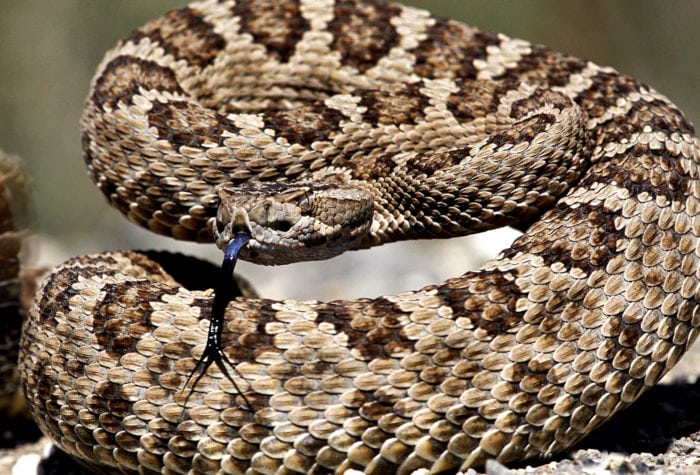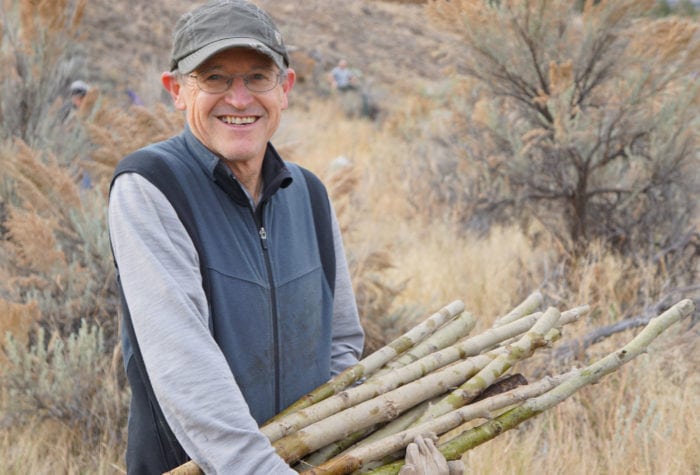Beech Creek Riparian Planting
Michael O'Casey
| Organizer: Gena Goodman-Campbell
Dates: October 23-26, 2022 Region: John Day River Basin Difficulty Rating: Level 3: Challenging Maximum Group Size: 15 participants |
About the place
Beech Creek Ranch was purchased by the Burns Paiute Tribe in 2015. This ranch, which is now managed as wildlife habitat, is within the John Day River basin and comprises 2,400 acres with 6 miles of anadromous fish bearing creek and riparian area, 160 acres of hay meadows, and the balance in juniper and bunch grass prairie.
The Burns Paiute Natural Resource Department’s preliminary goals for the property are: restoration of the riparian vegetative corridor, restoration of fish passage and in-stream habitat, conversion of degraded rangeland to productive wildlife habitat, improvement of irrigation efficiency and meadowland hay productivity, and development and preservation of ranch infrastructure. ONDA has agreed to partner with the Tribe to accomplish important restoration work that supports their objectives over the next four years.
About the stewardship work
Volunteers will work with ONDA and Burns Paiute Tribe staff to conduct two days of riparian planting along Beech Creek, planting species such as elderberry, golden currant and chokecherry.
We typically head to the work site at 8 a.m. and stop work by 4 p.m. in order to leave time in the afternoon to clean-up, relax, and cook a well-deserved dinner. No previous planting experience is needed to attend this trip. ONDA and Burns Paiute Tribe staff will provide all instruction and necessary tools to do the job. All that is required is a love of the high desert, a big smile, and a willingness to learn.
Trip Timeline
- Sunday, October 23, 5 p.m. We will meet at our campsite on the ranch to set up camp and get an overview of the project.
- Monday, October 24: After breakfast, we’ll meet up with Burns Paiute Tribe Wildlife staff at 8 a.m. and walk to the worksite on Beech Creek to begin our first day of planting. Volunteers should plan to be out all day and be prepared for a full day of walking, kneeling and doing physical work in weather that could range from cold and wet to hot and dry.
- Tuesday, October 25: After breakfast, we will walk to the worksite on Beech Creek to begin our second day of planting. Volunteers should plan to be out all day and be prepared for a full day of walking, kneeling and doing physical work in weather that could range from cold and wet to warm and dry. Volunteers are able to depart after the work day Tuesday if they would like to, or stay to pack up and drive after a good night’s sleep.
- Wednesday, October 26: Pack up to head home or spend some additional time exploring the surrounding area.
Camp
We will be car camping in an open meadow. Volunteers should plan to bring all necessary camping equipment to spend three nights outside in what could be overnight temperatures as cold as 20 degrees Fahrenheit. Burns Paiute Tribe will provide porta-potties, but there is no access to potable water.
Difficulty
The work will require walking approximately two miles each day, kneeling down and digging holes for plants, and carrying a daypack with food, water and ample clothing to stay warm and dry in variable conditions.
Participant responsibilities
Participants are responsible for their own food, water and camping gear as well as transportation to and from the trip (don’t forget your camp chair!). Volunteers should bring all the water they will need for drinking, cooking and cleaning. In the event of sunny and hot weather, please bring up to four liters of water capacity for the day, and consider an electrolyte replacement drink or mix to help you stay hydrated. Sturdy off-trail ankle-high boots, long pants, a long sleeve shirt (a lightweight sun shirt is a great option), and eye protection are required for this trip (sunglasses or prescription eyeglasses are suitable eye protection). Participants should be prepared to be away from camp all day and bring a daypack for lunch, snacks, and water.
Gear Provided
ONDA will provide tools for the work, work gloves, and sunscreen. ONDA will bring some group camping equipment (shade tent, tables for cooking, and wash bins for kitchen cleanup), extra potable water, and expert leadership.
Registration
An ONDA registration application and medical form are required for this trip.
Apply Now
You will receive a confirmation email within 2 weeks of submitting your form. The confirmation email will provide information regarding which trips you are on the “participant list” for, and which trips are full, and therefore you have been placed on the “wait list.”
Six weeks before the start of the trip, the trip leader will send out an RSVP to make sure everyone is still able to participate. Based on RSVPs, open spaces will be backfilled with people from the waitlist.
Three weeks before the trip start date, registered and confirmed participants will receive driving instructions, maps, and additional information in an email sent by the trip leader
If you have any questions in the meantime, please don’t hesitate to contact the trip leader.
Your Trip Leader
This trip will be led by Gena Goodman-Campbell. If you have questions, you can contact her at gena@onda.org.
Meet GenaRestoring Desert Ecosystems
ONDA works with partners, communities and the public to improve habitat quality, create healthy ecosystems, sustain clean water and support biodiversity in the high desert’s most ecologically important areas. What […]
Read More
